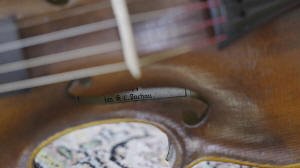A secret note hidden in Dachau-built ‘Violin of Hope’ tells a tale of
survival and craftsmanship
[April 28, 2025]
By JUSTIN SPIKE
BUDAPEST, Hungary (AP) — During World War II, within the walls of the
Nazi concentration camp at Dachau, a Jewish prisoner secretly penned a
short note and hid it inside a violin he had crafted under harrowing
circumstances — a message to the future that would remain undiscovered
for more than 80 years.
“Trial instrument, made under difficult conditions with no tools and
materials,” the worn note read. “Dachau. Anno 1941, Franciszek Kempa.”
The origins of the violin, built in 1941 by Franciszek “Franz” Kempa
while imprisoned by the Nazis at Dachau in southern Germany, remained
unnoticed for decades. It wasn’t until art dealers in Hungary sent the
instrument out for repairs — after having stored it for years among a
set of purchased furniture — that its history came to light.
Although the instrument's craftsmanship pointed clearly to a skilled
maker, the professional repairing it was puzzled by the poor quality of
the wood and the crude tools used to create it, which didn’t match the
evident skill involved.
“If you look at its proportions and structure, you can see that it’s a
master violin, made by a man who was proficient in his craft,” said
Szandra Katona, one of the Hungarian art dealers who discovered the
origins of the violin. “But the choice of wood was completely
incomprehensible.”

Motivated by the contradiction, the professional disassembled the
violin, revealing Kempa’s hidden note — an apparent explanation, even an
apology, from a master violin maker forced by the brutal limitations of
his captivity to build an instrument that fell short of his own
standards.
Dachau, located near Munich, was the first concentration camp
established by the Nazis in March 1933. It initially housed political
prisoners but later became a model for other camps, imprisoning Jews,
Roma, clergy, homosexuals, and others targeted by the Nazi regime.
[to top of second column]
|

This image obtained from AP video shows a tag with the text ''K.L.
Dachau'' seen through the f-holes of a Dachau-built instrument
dubbed the ''violin of hope'' in Magyarpolány, Hungary, Tuesday
April 22, 2025. (AP Photo/Nikolett Csanyi)
 Over time, it became a site of
forced labor, medical experiments, and brutal punishment, and
remained in operation until it was liberated by American forces on
April 29, 1945. At least 40,000 people are believed to have died
there due to starvation, disease, execution, or mistreatment.
There is ample evidence that musical instruments were present in
concentration camps across Central and Eastern Europe during World
War II. For propaganda purposes, the Nazis often permitted or even
encouraged the formation of musical groups to give a false
impression to the outside world about life in the camps.
However, all known instruments that survived Dachau are believed to
have been brought in by prisoners. Kempa’s “violin of hope,” as it
has come to be called, is the only known instrument actually built
inside the camp.
It is unknown how the violin left Dachau and ultimately made its way
to Hungary. But Kempa, according to documents provided to the
Hungarian art dealers by the museum at the Dachau memorial site,
survived the war and returned to his native Poland to continue
making instruments before dying in 1953.
The documents also suggest that Kempa was known to the Nazis as an
instrument maker — something Tamás Tálosi, one of the art dealers,
believes may have spared him the fate of millions of others that
perished in the camps.
“We named it the ‘violin of hope’ because if someone ends up in a
difficult situation, having a task or a challenge helps them get
through a lot of things,” Tálosi said. “You focus not on the
problem, but on the task itself, and I think this helped the maker
of this instrument to survive the concentration camp.”
All contents © copyright 2025 Associated Press. All rights reserved |